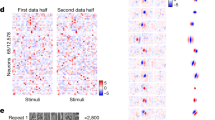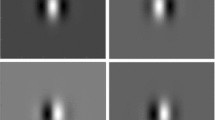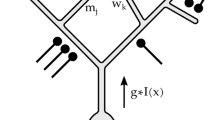Abstract.
The question of why the receptive fields of simple cells in the primary visual cortex are Gabor-like is a crucial one in vision research. Many research efforts (Olshausen and Field 1996, 1997; van Hateren and Ruderman 1998; van Hateren and van der Schaaf 1998) that yield a set of localized, oriented, and bandpass Gabor-like receptive fields believe that sparse and distributed is the coding goal of simple cells. This paper investigates a more general coding strategy that measures equally any departure from normality in the simple cells’ responses. That is, we investigate the possibility that highly kurtotic response histograms may result if simple cells explicitly seek, not maximally kurtotic, but rather maximally non-Gaussian response histograms to natural images. It is found that, under this coding strategy, the simulations produce a majority of localized, oriented, bandpass (Gabor-like) receptive fields. Some receptive fields, however, are spatially distributed and show little oriented structure. Nearly all receptive fields, regardless of whether they are Gabor-like or non-Gabor-like, yield highly kurtotic response histograms to natural images. Thus, in seeking maximally non-Gaussian response histograms, receptive fields spontaneously yield highly kurtotic histograms. The presence in our ensemble of nonlocalized, nonoriented receptive fields may be due to the artificial requirement that receptive fields be orthonormal. We conclude that the high kurtoses observed in the response histograms of simple-cell receptive fields to natural images may reflect a property of natural images themselves rather than an explicit coding goal used to structure simple-cell receptive fields.
Similar content being viewed by others
References
Atick JJ (1992) Could information theory provide an ecological theory of sensory processing? Network 2:213–251
Bell AJ, Sejnowski TJ (1996) Edges are the ‘‘independent components’’ of natural scenes. Adv Neural Inf Process Sys 9:831–837
Chubb CF, Lu ZL, Sperling G (1997) Structure detection: a statistically certified unsupervised learning procedure. Vis Res 37:3343–3365
Field DJ (1987) Relations between the statistics of natural images and the response properties of cortical cells. J Opt Soc Am A 4(12):2379–2394
Field DJ (1994) What is the goal of sensory coding? Neural Comput 6:559–601
Friedman JH (1987) Exploratory projection pursuit. J Am Stat Assoc 82:249–266
Hyvärinen A, Oja E (1997) A fast fixed-Point algorithm for independent component analysis. Neural Comput 9(7):1483–1492
Olshausen BA, Field DJ (1996) Emergence of simple-cell receptive field properties by learning a sparse code for natural images. Nature 381:607–609
Olshausen BA, Field DJ (1997) Sparse coding with an overcomplete basis set: a strategy employed by V1? Vis Res 37:3311–3325
Press WH, Flannery BP, Tueukolsky SA, Vetterling WT (1988) Numerical recipes in C . Cambridge University Press, Cambridge, UK
van Hateren JH, Ruderman DL (1998) Independent component analysis of natural image sequence yields spatiotemporal filters similar to simple cells in primary visual cortex. Proc R Soc Lond B 265:2315–2320
van Hateren JH, van der Schaaf A (1998) Independent component analysis of natural image compared with simple cells in primary visual cortex. Proc R Soc Lond B 265:359–366
Author information
Authors and Affiliations
Corresponding author
Additional information
Acknowledgement This work was supported by the US Office of Naval Research under agreement number N68936-00-2-0002.
Rights and permissions
About this article
Cite this article
Zhao, L. Is sparse and distributed the coding goal of simple cells?. Biol. Cybern. 91, 408–416 (2004). https://doi.org/10.1007/s00422-004-0524-0
Received:
Accepted:
Published:
Issue Date:
DOI: https://doi.org/10.1007/s00422-004-0524-0




